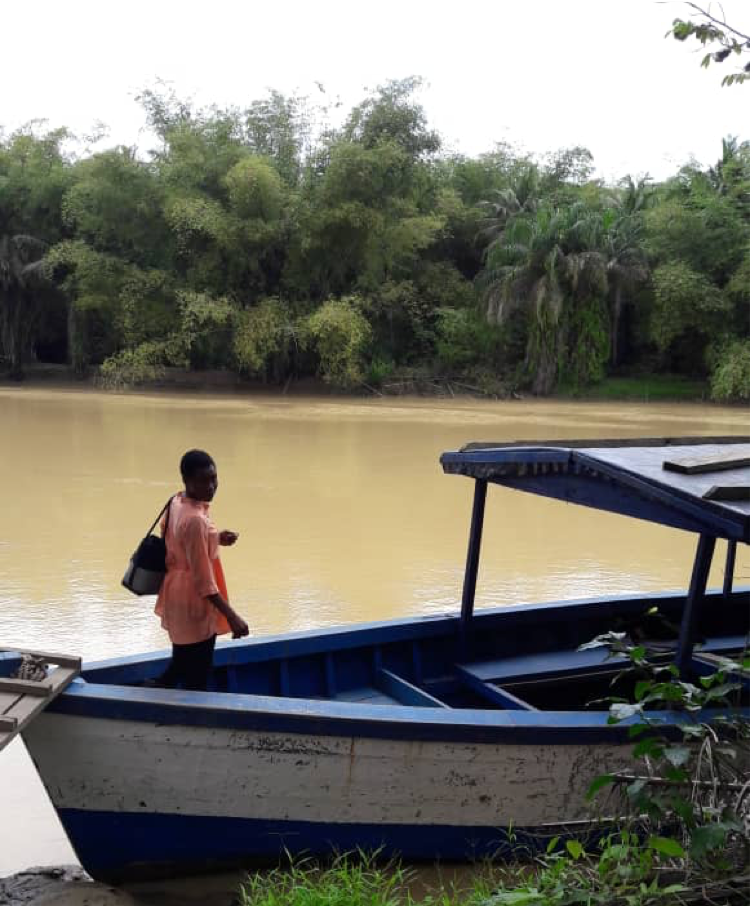
Irene Honam Tsey, Dodowa Health Research Centre, Ghana
During my last trip to the field in the latter part of 2018, I spent time observing people receiving drugs to control lymphatic filariasis. This fieldwork was part of the COUNTDOWN study which is exploring community health volunteers’ experiences of working with neglected tropical disease programmes to deliver drugs at the community level. My observations made me realise how challenging implementing this programme can be and raised questions about whether simply delivering drugs is sufficient.
We visited two villages in the Western region of Ghana considered very hard to reach due to their geographical location. The villages are forest settlements with cocoa farms and cottages and one of these is only accessible by boat or canoe.

The other was accessible by car along an untarred and poorly maintained road. People living here had migrated from the northern part of Ghana and were working on farms with their families. Due to the nature of these settlements which are scattered and in the rain forest, house to house distribution of the drugs was very difficult and there was no community drug distributor present in the community. We decided to visit this community because in selecting the participants for the study we wanted as much as possible to include a range of communities to understand the scope of experiences and how may vary in different contexts. In trying to enquire about volunteers from hard to reach communities, we were informed by the Neglected Tropical Diseases (NTDs) focal person that Mass Drug Administration (MDA) had stopped taking place in such communities because they had no community health volunteer. The focal person informed the sub - district focal person who is also a community health nurse and she agreed to go with us so she could organise an outreach program for mothers and their children under five years as well administer the drugs to the community members. Prior to our visit, one of the community leaders representing these communities was informed.
In this community, the administration of drugs had not happened for more than 5 years since the community health volunteer passed away and no other community resident felt able to volunteer – perhaps reflecting the challenging conditions they would have to negotiate to distribute drugs. In both communities, from the central meeting point to the closest hut or cottage took about 45 minutes by foot.

With a team made up of us two researchers, the district NTD focal person and a community health nurse) arriving at the central point where community members had gathered and were ready to administer the drugs through DOT; it came to light that there was no drinking water available. Whilst deliberating on what to do about the situation, most of the community members were talking about the distance to their cottages and their hesitance to walk such a distance and back. Interestingly, the central meeting place was just along the River Pra which has been destroyed due to Galamsey (small scale illegal mining) activities. A young mother quickly removed her baby strapped at her back, gave the baby to another woman and sped off. Unknown to us and to our surprise she had decided to go get a gallon of drinking water from her cottage. Unfortunately, her baby kept crying for the whole period the mother was away. However, after a long wait, she returned with a gallon of water on her head.
In the other hard to reach community visited by the team, the road was terrible and not accessible in the rainy season. However, the team was able to make the trip because the research team came with a land cruiser. Upon arriving at the community after a bumpy ride of 30 minutes to the main central meeting point, we were informed by the community members that the Galamsey (small scale illegal mining) activities had destroyed their main source of drinking water and for some time they have not been able to draw water. They added that they need to wait for the water (which was at the time muddy) to settle – usually by the evening - for them to be able to fetch the water and take the drugs. The team therefore drove back to the closest town to buy some bags of sachet drinking water for the MDA to take place.
These experiences speak to the complex challenges faced during mass drug administration, the realities within rural hard to reach contexts and the challenges faced by both communities and community health volunteers. Moreover, this adds to the existing discussion on MDA success and poses the question whether it is enough to just provide drugs for distribution?
